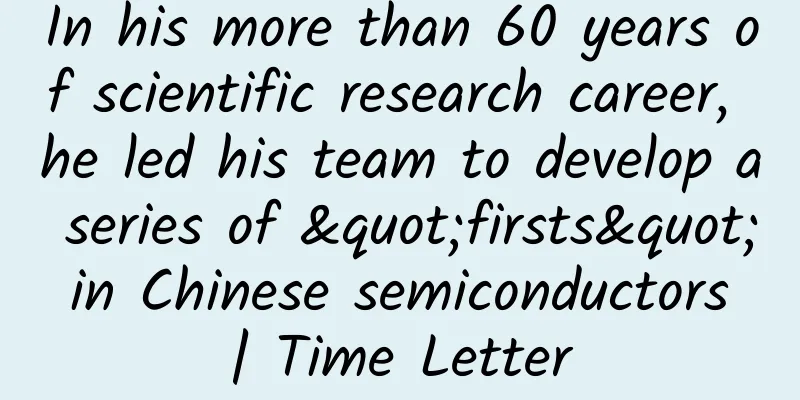In his more than 60 years of scientific research career, he led his team to develop a series of "firsts" in Chinese semiconductors | Time Letter

|
In July 1977, a semiconductor scientist spoke at a national symposium for scientific and educational workers: "There are more than 600 semiconductor production factories in the country, and the total amount of integrated circuits they produce in a year is only one-tenth of the monthly output of a 2,000-person factory in Japan. This decentralized and inefficient production method should be changed as soon as possible." He suggested: "First, we must grasp the key and solve the problem of improving the yield rate of large-scale integrated circuits. Second, we must concentrate our efforts and use the manpower and material resources of hundreds of factories on two or three key factories so that the equipment conditions of the key factories can catch up with the international level." The semiconductor scientist who spoke at the meeting was Wang Shouwu. After the founding of New China, Wang Shouwu, who was studying in the United States, and his wife decided to return to China to participate in the construction. In 1950, Wang Shouwu returned to China with his wife and daughter and joined the Institute of Applied Physics of the Chinese Academy of Sciences. In decades of scientific research and work, he devoted his life to my country's microelectronics and semiconductor technology. Wang Shouwu (third row, second from right) and his wife Ge Xiuhuai on the passenger ship "President Cleveland" in 1950 Source | Old Scientist Academic Growth Data Collection Project Recalling Wang’s more than 60 years of scientific research career, he led the scientific research team to develop a series of "firsts" in China's semiconductors: successfully developing my country's first transistor, my country's first gallium arsenide semiconductor laser, and 4,000-bit and 16,000-bit DRAM large-scale integrated circuits... promoting my country's semiconductor industry from scratch to something, and from weak to strong. Mr. Wang Shouwu debugging the probe station in 1979 Source | Old Scientist Academic Growth Data Collection Project For decades, Wang Shouwu has always been practicing his original intention and mission of putting the needs of the country first. He once said: "At that time, I just wanted to make some contributions to the motherland and go wherever I was needed." In his autobiographical article "My Journey to Serving the Country", Wang Shouwu wrote: As long as a scientific worker has a heart to serve the country, a spirit of seeking truth from facts, acts strictly in accordance with scientific laws, asks more questions when encountering problems, objectively analyzes problems and finds causes, and is perseverant, he will be able to continuously achieve victorious results on the road to serving the country, and make achievements and contributions to the socialist cause of the Party and the country. Sources of Scientists' Manuscripts | Old Scientists' Academic Growth Data Collection Project It is precisely because of his love for science and his rigorous scientific style that this "pioneer" in semiconductor research has led China to embark on a path of self-reliance and self-improvement in creating "chips". Wang Shouwu (1919-2014) Microelectronics Scientist Semiconductor device physicist Academician of the Chinese Academy of Sciences Special thanks to this column Academic growth data collection project for senior scientists Provide material support |
<<: Why does China need its own space station?
Recommend
The efficacy and function of golden scissors grass
Do you know golden scissors grass? It is a common...
Research finds that people who often eat "technology and hard work" tend to be emo
Recently, the news that a certain actor is suspec...
The effect of wolfberry saffron wine
Whether at some small gatherings or at large cock...
Chinese herbal medicine for cough and phlegm
When people have symptoms of coughing, they can c...
"You can't live without being crazy!" How do weasels evolve the "soft power" that you can't imagine?
In this age when humans go crazy from time to tim...
The efficacy and function of Sichuan and Guizhou Schefflera
The world is full of wonders, and Chinese medicin...
The efficacy and function of Cotoneaster chinensis
As the pressure of modern life increases, more an...
The efficacy of deer bite grass
You may not have heard of the medicinal herb Deer...
The "king of anthocyanins" is not blueberry but this! Eating more can protect the brain, eyes, and inflammation, and can also reduce the risk of coronary heart disease!
Author: Xue Qingxin, registered nutritionist Revi...
The efficacy and function of sword bean root
Sword bean root is a kind of traditional Chinese ...
The efficacy and function of the two-pointed
In fact, the occurrence of many human diseases is...
Is it good to eat motherwort for menstrual disorders?
There are many reasons for menstrual disorders, b...
Does Vinegar-Stir-fried Potato Shreds contain Slow-Digesting Starch? How to Eat Potatoes Without Surges in Blood Sugar?
Everyone knows that potatoes (scientific name Sol...
World Food Day | These foods you often eat grow in the ground. Do you still recognize them?
Today is World Food Day . Let's do a little t...
The efficacy and function of Mengzi water celery
In fact, the occurrence of many human diseases is...









